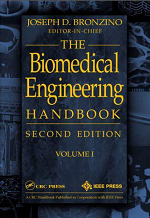_Biomedical_Engineering_Handbook,_Volume II 2nd Ed
- Biomedical engineering, then, is an interdisciplinary branch of engineering that ranges from theoretical, nonexperimental undertakings to state-of-the-art applications. It can encompass research, development, implementation, and operation. Accordingly, like medical practice itself, it is unlikely that any single person can acquire expertise that encompasses the entire field. Yet, because of the interdisciplinary nature of this activity, there is considerable interplay and overlapping of interest and effort between them. For example, biomedical engineers engaged in the development of biosensors may interact with those interested in prosthetic devices to develop a means to detect and use the same bioelectric signal to power a prosthetic device. Those engaged in automating the clinical chemistry laboratory may collaborate with those developing expert systems to assist clinicians in making decisions based on specific laboratory data. The possibilities are endless.
- 3189 pages
nonexperimental undertakings to state-of-the-art applications. It can encompass research, development,
implementation, and operation. Accordingly, like medical practice itself, it is unlikely that any
single person can acquire expertise that encompasses the entire field. Yet, because of the interdisciplinary
nature of this activity, there is considerable interplay and overlapping of interest and effort between them.
For example, biomedical engineers engaged in the development of biosensors may interact with those
interested in prosthetic devices to develop a means to detect and use the same bioelectric signal to power
a prosthetic device. Those engaged in automating the clinical chemistry laboratory may collaborate with
those developing expert systems to assist clinicians in making decisions based on specific laboratory data.
The possibilities are endless.












